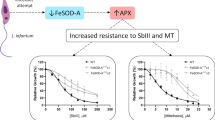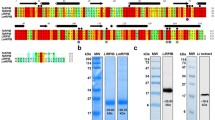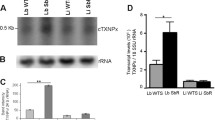Abstract
Leishmania must survive oxidative stress, but lack many classical antioxidant enzymes and rely heavily on trypanothione-dependent pathways. We used forward genetic screens to recover loci mediating oxidant resistance via overexpression in Leishmania major, which identified pteridine reductase 1 (PTR1). Comparisons of isogenic lines showed ptr1 − null mutants were 18-fold more sensitive to H2O2 than PTR1-overproducing lines, and significant three- to fivefold differences were seen with a broad panel of oxidant-inducing agents. The toxicities of simple nitric oxide generators and other drug classes (except antifolates) were unaffected by PTR1 levels. H2O2 susceptibility could be modulated by exogenous biopterin but not folate, in a PTR1- but not dihydrofolate reductase-dependent manner, implicating H4B metabolism specifically. Neither H2O2 consumption nor the level of intracellular oxidative stress was affected by PTR1 levels. Coupled with the fact that reduced pteridines are at least 100-fold less abundant than cellular thiols, these data argue strongly that reduced pteridines act through a mechanism other than scavenging. The ability of unconjugated pteridines to counter oxidative stress has implications to infectivity and response to chemotherapy. Since the intracellular pteridine levels of Leishmania can be readily manipulated, these organisms offer a powerful setting for the dissection of pteridine-dependent oxidant susceptibility in higher eukaryotes.






Similar content being viewed by others
Abbreviations
- PTR1:
-
Pteridine reductase 1
- DHFR-TS:
-
Dihydrofolate reductase-thymidylate synthase
- ROS:
-
Reactive oxygen species
- RNS:
-
Reactive nitrogen species
- DCFH-DA:
-
2′7′-Dichlorofluorescein diacetate
- DCF:
-
Dichlorofluorescin
- GSH:
-
Glutathione
- T[SH]2 :
-
Trypanothione
- SIN-1:
-
3-Morpholino-sydnonimine
- H2B:
-
Dihydrobiopterin
- H4B:
-
Tetrahydrobiopterin
- WT:
-
Wild-type
References
Ariyanayagam MR, Fairlamb AH (2001) Ovothiol and trypanothione as antioxidants in trypanosomatids. Mol Biochem Parasitol 115:189–198
Ashutosh, Sundar S, Goyal N (2007) Molecular mechanisms of antimony resistance in Leishmania. J Med Microbiol 56:143–153
Augusto O, Alves MJM, Colli W, Filardi LS, Brener S (1986) Primaquine can mediate hydroxyl radical generation by Trypanosoma cruzi extracts. Biochem Biophys Res Commun 135:1029–1034
Bello AR, Nare B, Freedman D, Hardy L, Beverley SM (1994) PTR1: a reductase mediating salvage of oxidized pteridines and methotrexate resistance in the protozoan parasite Leishmania major. Proc Natl Acad Sci 91:11442–11446
Beverley SM (1991) Gene Amplification in Leishmania. Annu Rev Microbiol 45:417–444
Beverley SM (2003) Genetic and genomic approaches to the analysis of Leishmania virulence. In: Marr JM, Nilsen T, Komuniecki R (eds) Molecular and medical parasitology. Academic Press, New York
Beverley SM, Coderre JA, Santi DV, Schimke RT (1984) Unstable DNA amplifications in methotrexate resistant Leishmania consist of extra-chromosomal circles which relocate during stabilization. Cell 38:431–439
Bishai WR, Howard NS, Winkelstein JA, Smith HO (1994) Characterization and virulence analysis of catalase mutants of Haemophilus influenzae. Infect Immun 62:4855–4860
Brudler R, Hitomi K, Daiyasu H, Toh H, Kucho K, Ishiura M, Kanehisa M, Roberts VA, Todo T, Tainer JA, Getzoff ED (2003) Identification of a new cryptochrome class. Structure, function, and evolution. Mol Cell 11:59–67
Callahan HL, Beverley SM (1991) Heavy metal resistance: a new role for P-glycoproteins in Leishmania. J Biol Chem 266:18427–18430
Clos J, Choudhury K (2006) Functional cloning as a means to identify Leishmania genes involved in drug resistance. Mini Rev Med Chem 6:123–129
Cotrim PC, Garrity LK, Beverley SM (1999) Isolation of genes mediating resistance to inhibitors of nucleoside and ergosterol metabolism in Leishmania by overexpression/selection. J Biol Chem 274:37723–37730
Cruz A, Beverley SM (1990) Gene replacement in parasitic protozoa. Nature 348:171–173
Cruz A, Coburn C, Beverley SM (1991) Double targeted gene replacement for creating null mutants. Proc Natl Acad Sci 88:7170–7174
Cruz AK, Titus R, Beverley SM (1993) Plasticity in chromosome number and testing of essential genes in Leishmania by targeting. Proc Natl Acad Sci USA 90:1599–1603
Cunningham ML, Beverley SM (2001) Pteridine salvage throughout the Leishmania infectious cycle: implications for antifolate chemotherapy. Mol Biochem Parasitol 113:199–213
Cunningham ML, Titus RG, Turco SJ, Beverley SM (2001) Regulation of differentiation to the infective stage of the protozoan parasite Leishmania major by tetrahydrobiopterin. Science 292:285–287
Davies KJ (1995) Oxidative stress: the paradox of aerobic life. Biochem Soc Symp 61:1–31
Denicola A, Rubbo H, Rodriguez D, Radi R (1993) Peroxynitrite-mediated cytotoxicity to Trypanosoma cruzi. Arch Biochem Biophys 304:279–286
Denkers EY, Butcher BA (2005) Sabotage and exploitation in macrophages parasitized by intracellular protozoans. Trends Parasitol 21:35–41
Desjeux P (2004) Leishmaniasis: current situation and new perspectives. Comp Immunol Microbiol Infect Dis 27:305–318
Devine SE, Boeke JD (1994) Efficient intergration of artificial transposons into plasmid targets in vitro: a useful tool for DNA mapping, sequencing and genetic analysis. Nucleic acid Res 22:3765–3772
Dumas C, Ouellette M, Tovar J, Cunningham ML, Fairlamb AH, Tamar S, Olivier M, Papadopoulou B (1997) Disruption of the trypanothione reductase gene of Leishmania decreases its ability to survive oxidative stress in macrophages. EMBO J 16:2590–2598
Ellenberger TE, Beverley SM (1989) Multiple drug resistance and conservative amplification of the H region in Leishmania major. J Biol Chem 264:15094–150103
Fairlamb AH, Cerami A (1992) Metabolism and functions of trypanothione in the kinetoplastida. Annu Rev Microbiol 46:695–729
Fang FC (2004) Antimicrobial reactive oxygen and nitrogen species: concepts and controversies. Nat Rev 2:820–832
Feelisch M, Ostrowski J, Noack E (1989) On the mechanism of NO release from sydnonimines. J Cardiovasc Pharmacol 14:S13–S22
Garraway LA, Tosi LRO, Wang Y, Moore JB, Dobson DE, Beverley SM (1997) Insertional mutagenesis using a modified in vitro Ty1 transposition system. Gene 198:27–36
Gatti RM, Augusto O, Kwee JK, Giorgio S (1995) Leishmanicidal activity of peroxynitrite. Redox Rep 1:261–265
Homan-Muller JWT, Weening RT, Roos D (1975) Production of hydrogen peroxide by phagocytizing human granulocytes. J Lab Clin Med 85:198–207
Huang HM, Chen HL, Xu H, Gibson GE (2005) Modification of endoplasmic reticulum Ca2+ stores by select oxidants produces changes reminiscent of those in cells from patients with Alzheimer disease. Free Radic Biol Med 39:979–989
Iyer JP, Kaprakkaden A, Choudhary ML, Shaha C (2008) Crucial role of cytosolic tryparedoxin peroxidase in Leishmania donovani survival, drug response and virulence. Mol Microbiol 68:372–391
Jaeger T, Flohe L (2006) The thiol-based redox networks of pathogens: unexploited targets in the search for new drugs. Biofactors 27:109–120
Kapler GM, Coburn CM, Beverley SM (1990) Stable transfection of the human parasite Leishmania major delineates a 30-kilobase region sufficient for extrachromosomal replication and expression. Mol Cell Biol 10:1084–1094
Kaufman S (1963) The structure of phenylalanine hydroxylation cofactor. Proc Natl Acad Sci 50:1085–1093
Kelly JM, Taylor MC, Smith K, Hunter KJ, Fairlamb AH (1993) Phenotype of recombinant Leishmania donovani and Trypanosoma cruzi which over-express trypanothione reductase. Sensitivity towards agents that are thought to induce oxidative stress. Eur J Biochem 218:29–37
Keston AS, Brandt R (1965) The fluorimetric analysis of ultramicroquantities of hydrogen peroxide. Anal Biochem 11:1–5
Kirsch M, Korth HG, Stenert V, Sustmann R, de Groot H (2003) The autoxidation of tetrahydrobiopterin revisited. Proof of superoxide formation from reaction of tetrahydrobiopterin with molecular oxygen. J Biol Chem 278:24481–24490
Kosar-Hashemi B, Armarego WLF (1993) A convenient spectrophotometric method for measuring the kinetic parameters of glyceryl-ether monooxygenase (EC1.14.16.5). Biol Chem Hoppe-Seyler 374:9–25
Krauth-Siegel RL, Ludemann H (1996) Reduction of dehydroascorbate by trypanothione. Mol Biochem Parasitol 80:203–208
Krauth-Siegel RL, Meiering SK, Schmidt H (2003) The parasite-specific trypanothione metabolism of Trypanosoma and Leishmania. Biol Chem 384:539–549
Krauth-Siegel LR, Comini MA, Schlecker T (2007) The trypanothione system. Subcell Biochem 44:231–251
Liew FY, Millott S, Parkinson C, Palmer RMJ, Moncada S (1990) Macrophage killing of Leishmania parasite in vivo is mediated by nitric oxide from l-arginine. J Immunol 144:4794–4797
Ma D, Beverley SM, Turco SJ (1996) Leishmania donovani possess a NADPH-dependent alkylglyceryl cleavage enzyme. Biochem Biophys Res Commun 227:885–889
Marchini JF, Cruz AK, Beverley SM, Tosi LR (2003) The H region HTBF gene mediates terbinafine resistance in Leishmania major. Mol Biochem Parasitol 131:77–81
Milstien S, Katusic Z (1999) Oxidation of tetrahydrobiopterin by peroxynitrite: implications for vascular endothelial function. Biochem Biophys Res Commun 263:681–684
Moreira W, Leblanc E, Ouellette M (2009) The role of reduced pterins in resistance to reactive oxygen and nitrogen intermediates in the protozoan parasite Leishmania. Free Radic Biol Med 46:367–375
Moutiez M, Meziane-Cherif D, Aumercier M, Sergheraert C, Tartar A (1994) Compared reactivities of trypanothione and glutathione in conjugation reactions. Chem Pharmacol Bull 42:2641–2644
Nare B, Hardy L, Beverley SM (1997a) The roles of pteridine reductase 1 (PTR1) and dihydrofolate reductase-thymidylate synthase (DHFR-TS) in pteridine metabolism in the protozoan parasite Leishmania major. J Biol Chem 272:13883–13891
Nare B, Luba J, Hardy LW, Beverley S (1997b) New approaches to Leishmania chemotherapy: pteridine reductase 1 (PTR1) as a target and modulator of antifolate sensitivity. Parasitology 114:S101–S110
Oettl K, Reibnegger G (2002) Pteridine derivatives as modulators of oxidative stress. Curr Drug Metab 3:203–209
Ouellette M, Legare D, Papadopoulou B (1994) Microbial multidrug-resistance ABC transporters. Trends Microbiol 2:407–411
Ouellette M, Drummelsmith J, El-Fadili A, Kundig C, Richard D, Roy G (2002) Pterin transport and metabolism in Leishmania and related trypanosomatid parasites. Int J Parasitol 32:385–398
Ouellette M, Drummelsmith J, Papadopoulou B (2004) Leishmaniasis: drugs in the clinic, resistance and new developments. Drug Resist Updat 7:257–266
Penketh PG, Klein RA (1986) Hydrogen peroxide metabolism in Trypanosoma brucei. Mol Biochem Parasitol 20:111–121
Pick E, Keisari Y (1980) A simple calorimetric assay for the measurement of hydrogen peroxide produced by cells in culture. J Immunol Methods 38:161–170
Plewes KA, Barr SD, Gedamu L (2003) Iron superoxide dismutases targeted to the glycosomes of Leishmania chagasi are important for survival. Infect Immun 71:5910–5920
Robinson JP, Bruner LH, Bassoe CF, Hudson JL, Ward PA, Phan SH (1988) Measurement of intracellular fluorescence of human monoctytes relative to oxidative metabolism. J Leucoc Biol 43:304–310
Roy G, Kundig C, Olivier M, Papadopoulou B, Ouellette M (2001) Adaptation of Leishmania cells to in vitro culture results in a more efficient reduction and transport of biopterin. Exp Parasitol 97:161–168
Ryan KA, Dasgupta S, Beverley SM (1993) Shuttle cosmid vectors for the trypanosomatid parasite Leishmania. Gene 131:145–150
Sancar A (2004) Photolyase and cryptochrome blue-light photoreceptors. Adv Protein Chem 69:73–100
Spath GF, Garraway LA, Turco SJ, Beverley SM (2003) The role(s) of lipophosphoglycan (LPG) in the establishment of Leishmania major infections in mammalian hosts. Proc Natl Acad Sci USA 100:9536–9541
Stamler JS (1994) Redox signalling: nitrosylation and related target interactions of nitric oxide. Cell 78:931–936
Tayeh MA, Marletta MA (1989) Macrophage oxidation of l-argenine to nitric oxide, nitrite and nitrate. J Biol Chem 264:19654–19658
Titus RG, Gueiros-Filho FJ, de Freitas LA, Beverley SM (1995) Development of a safe live Leishmania vaccine line by gene replacement. Proc Natl Acad Sci USA 92:10267–10271
Vergauwen B, Herbert M, Van Beeumen JJ (2006) Hydrogen peroxide scavenging is not a virulence determinant in the pathogenesis of Haemophilus influenzae type b strain Eagan. BMC microbiology 6:3
Vogt RN, Steenkamp DJ (2003) The metabolism of S-nitrosothiols in the trypanosomatids: the role of ovothiol A and trypanothione. Biochem J 371:49–59
Wanasen N, Soong L (2008) l-Arginine metabolism and its impact on host immunity against Leishmania infection. Immunol Res 41:15–25
Wang J, Leblanc E, Chang CF, Papadopoulou B, Bray T, Whiteley JM, Lin SX, Ouellette M (1997) Pterin and folate reduction by the Leishmania tarentolae H locus short- chain dehydrogenase/reductase PTR1. Arch Biochem Biophys 342:197–202
Werner-Felmayer G, Golderer G, Werner ER (2002) Tetrahydrobiopterin biosynthesis, utilization and pharmacological effects. Curr Drug Metab 3:159–173
Wyllie S, Cunningham ML, Fairlamb AH (2004) Dual action of antimonial drugs on thiol redox metabolism in the human pathogen Leishmania donovani. J Biol Chem 279:39925–39932
Acknowledgments
We thank James Schwarz for help with flow cytometry, and Dr. David Scott for providing the FV1 ptr1 −/SSU::PTR1 line. We thank Alan Fairlamb and CC Wang for their discussions and comments on this work, and are grateful to the members of the lab for critical comments on the manuscript, including M. Cunningham, D. Dobson, L. Epstein, F. Gueiros-Filho, L. Garrity, J. Moore, K. R. Nagar-Anthal, and D. Scott. Supported by NIH grant AI21903.
Author information
Authors and Affiliations
Corresponding author
Additional information
Communicated by G. Kapler.
Rights and permissions
About this article
Cite this article
Nare, B., Garraway, L.A., Vickers, T.J. et al. PTR1-dependent synthesis of tetrahydrobiopterin contributes to oxidant susceptibility in the trypanosomatid protozoan parasite Leishmania major . Curr Genet 55, 287–299 (2009). https://doi.org/10.1007/s00294-009-0244-z
Received:
Revised:
Accepted:
Published:
Issue Date:
DOI: https://doi.org/10.1007/s00294-009-0244-z




